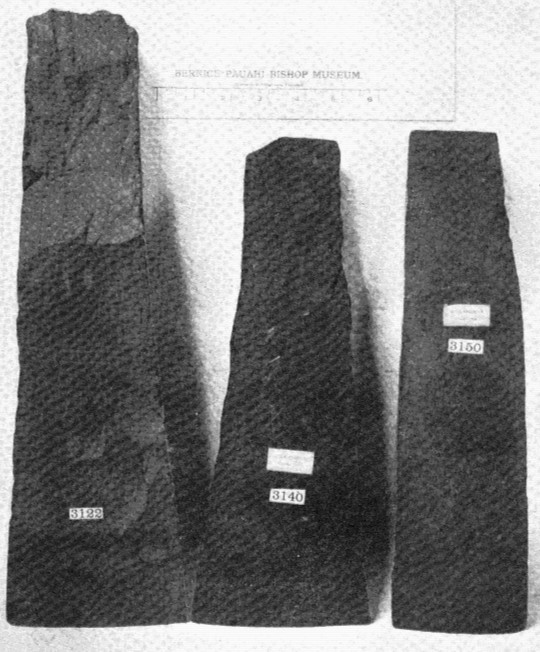Note: This article has been excerpted from a larger work in the public domain and shared here due to its historical value. It may contain outdated ideas and language that do not reflect TOTA’s opinions and beliefs.
“The Stone Ax and the New Ax” from Hawaiian Antiquities by David Malo, 1903.
1. The ax of the Hawaiians was of stone. The art of making it was handed down from remote ages. Ax-makers were a greatly esteemed class in Hawaii nei. Through their craft was obtained the means of felling trees and of cutting and hewing all kinds of timber used in every sort of wood-work. The manner of making an ax was as follows:
2. The ax-makers (poe ka-ko'i) prospected through the Mountains and other places in search of hard stones suitable for ax-making, carrying with them certain other pieces of hard stone, some of them angular and some of them round in shape, called haku ka-koi, to be used in chipping and forming the axes.
3. After splitting the rock and obtaining a long fragment, they placed it in a liquor made from vegetable juices (wai-laau) which was supposed to make it softer, and this accomplished, they chipped it above and below, giving it the rude shape of an ax.
4. The lower part of the ax which is rounded (e polipoli ana) is termed the pipi; the upper part which forms an angle with it is termed the hau-hana. When the shape of the thing has been blocked out, they apply it to the grind-stone, hoana, sprinkled with sand and water. The upper side and the lower side were ground down and then the edge was sharpened. The joiner's ax (koi kapili) had a handle of hau, or some other wood.
5. The next thing was to braid some string, to serve as a lashing, to fit the handle to the ax, to wrap a protecting cloth (pale) about it (in order to save the lashing from being cut by the chips), and lastly, to bind the ax firmly to the handle, which done, the ax was finished. The ax now became an object of barter with this one and that one, and thus came into the hands of the canoe-maker.
6. The shell called o-le served as an ax for some purposes, also a hard wood called ala-hee. There were a few axes made from (scraps of) iron, but the amount of iron in their possession was small. It was with such tools as these that the Hawaiians hewed out their canoes, house-timber and did a great variety of wood-work. The ax was by the ancients reckoned an article of great value. How pitiful!
7. Now come new kinds of axes from the lands of the white man. But iron had reached Hawaii before the arrival of the foreigner, a jetsam iron which the chiefs declared sacred to the gods. (He hao pae, ua hai na ‘lli i na 'kua kii.)
8. There was, however, very little iron here in those old times. But from the days of Kamehameha I down to those of Kamehameha III, iron has been abundant in this country.
9. Iron is plentiful now, and so are all kinds of iron tools, including the kitchen-ax, the hatchet, the adze, broad-ax, chisel, etc.
These are the new tools which have been imported. The stone-ax (koi-pohaku) is laid aside.
Malo, David. Hawaiian Antiquities: (Moolelo Hawaii). Translated by Nathaniel Bright Emerson, Hawaiian Gazette Co., 1903.
About TOTA
TOTA.world provides cultural information and sharing across the world to help you explore your Family’s Cultural History and create deep connections with the lives and cultures of your ancestors.


